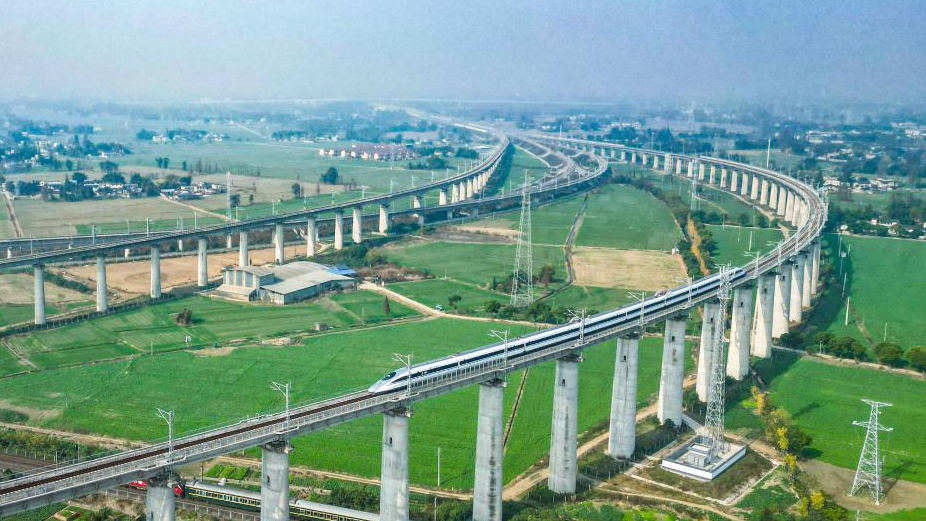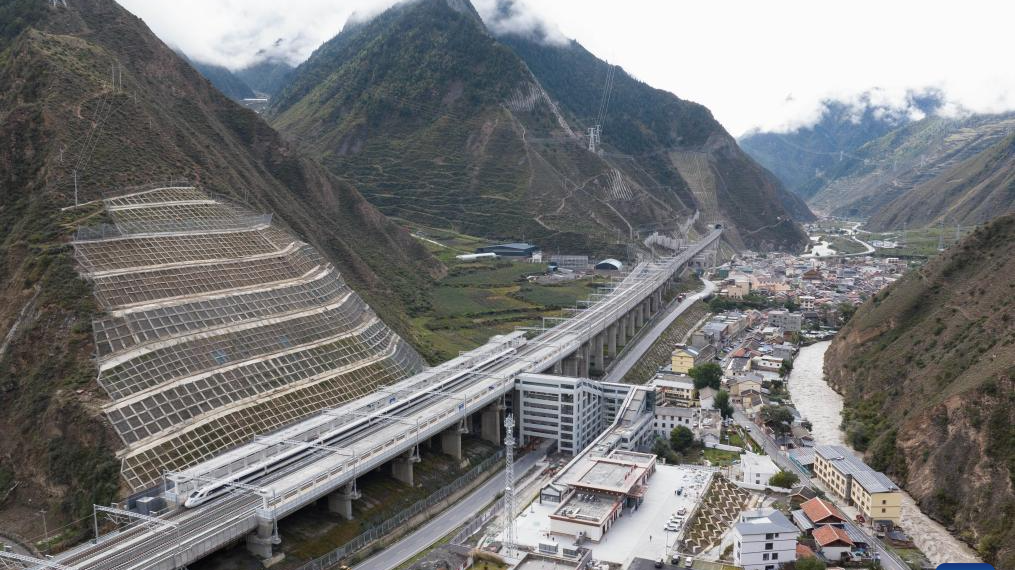
A high-speed passenger train, C6008, runs along the Sichuan-Qinghai Railway in Chengdu City, southwest China's Sichuan Province, November 28, 2023. /Xinhua
A high-speed passenger train, C6008, runs along the Sichuan-Qinghai Railway in Chengdu City, southwest China's Sichuan Province, November 28, 2023. /Xinhua
A 238-kilometer section of the Sichuan-Qinghai Railway in western China opened on Tuesday after 12 years of construction.
It crosses the rugged, earthquake-prone plateau region to avoid disturbing the Giant Panda National Park in southwest China's Sichuan Province.
A high-speed passenger train, C6008, departed around 11 a.m. from Maoxian County, Aba Tibetan and Qiang Autonomous Prefecture, southwest China's Sichuan Province, for capital Chengdu. The railway section is designed to enable a 238-kilometer journey in just 55 minutes.
At an altitude of some 1,500 meters, Maoxian is the country's largest area inhabited by the people of Qiang ethnic group. They now have a new option of traveling by high-speed trains.
Yongqingtsu, the conductor of Tuesday's train service, described the trip of about an hour as "smooth and comfortable."
As the railway is built mostly in mountains, "more than half of the journey is in tunnels, which is like riding the subway," he said, adding that the constant change in elevation also makes the trip like being on a super long escalator.

People pose for photos at Maoxian Railway Station in Maoxian County, southwest China's Sichuan Province, November 28, 2023. /Xinhua
People pose for photos at Maoxian Railway Station in Maoxian County, southwest China's Sichuan Province, November 28, 2023. /Xinhua
Panda habitat protection
A highlight of this project is that it has been built with the wild panda habitat in mind.
China officially opened the Giant Panda National Park in 2021, which covers parts of Sichuan, Shaanxi and Gansu provinces.
Mu Yalin, the project's designer from China Railway Eryuan Engineering Group Co., Ltd., told China Media Group (CMG) that in order to minimize the impact on ecological corridors that are crucial to exchanges between different groups of giant pandas, the railway either makes detours or goes through tunnels as deep as possible.
"Sometimes we need to do 20 percent extra work in the construction due to the special design," Mu said, adding that the tunnels under the Tudiling giant panda corridor are buried more than 1,000 meters deep, so that the traffic and the surface do not affect each other.
The tunnels were drilled through the famous Longmenshan fault zone, which has been struck by a number of devastating earthquakes, including a magnitude-8.0 quake on May 12, 2008.
Wang Zhigang, who is in charge of construction projects undertaken by the China Railway 12th Bureau Group Co., Ltd., said engineers and builders had tackled numerous formidable obstacles with breakthroughs in technology and construction methods during 12 years of construction work.

A high-speed passenger train makes a stop at Zhenjiangguan Railway Station in southwest China's Sichuan Province, November 13, 2023. /Xinhua
A high-speed passenger train makes a stop at Zhenjiangguan Railway Station in southwest China's Sichuan Province, November 13, 2023. /Xinhua
Sichuan-Qinghai Railway
Construction is still underway of the Sichuan-Qinghai Railway, which will eventually stretch northwestward to Xining, the capital city of Qinghai Province, with a designed length of about 836 kilometers and speed of 200 kilometers per hour.
Upon completion of the whole project, the new rail line will connect the Qinghai-Xizang Plateau, the world's highest plateau, with the massive high-speed transport network of China, putting the region's development on fast track.
The operational line also goes through an array of cultural and scenic attractions, such as the Jiuzhai Valley, a UNESCO World Heritage site famed for its spectacular waterfalls, lush forests, serene plateau lakes and karst rock formations, and the famed Sanxingdui Ruins featuring the ancient Shu civilization dating back more than 3,000 years.
(With input from Xinhua)




